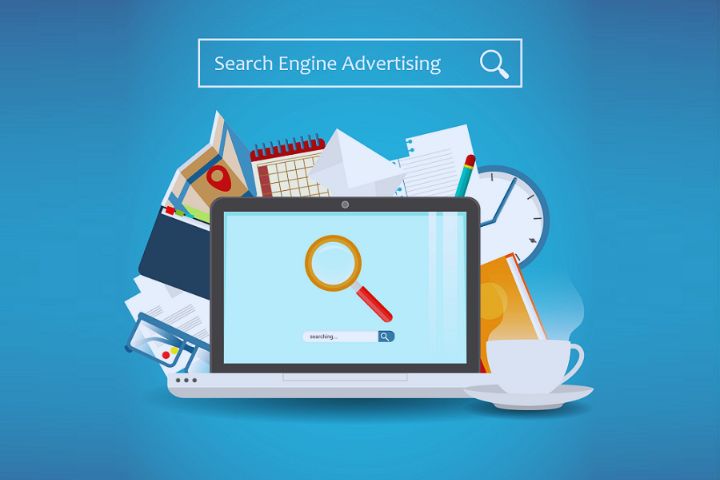Search Engine Advertising Or SEA: Basic Concepts Of Search Engine Advertising

Search Engine Advertising or SEA, is one of the two areas of action of SEM or search engine marketing, as search engine advertising or search engine advertising. It is also common to find it as Keyword-Advertising or simply PPC, from the English Pay per Click, referring to the payment system used.
SEA strategies are responsible for advertising that appears in search results and on associated pages, as opposed to SEO, which seeks web optimization through content strategies. In any case, search engine advertising includes sponsored links that appear above, below or to the side of organic results, and not only on Google. Bing and Yahoo also offer this type of advertising and in all cases it represents an important source of income for search engines, if not the largest.
Table of Contents
How Does SEA Work?
The principle of operation of search engine advertising is quite simple. Before publishing an ad in the most used search engines, keywords are defined that correspond to the search terms that Internet users use to reach this or other pages with a similar theme and that are relevant to the advertiser page. The set of keywords prepared is used to create the advertising texts and, finally, the price that the company is willing to pay for each click that users make is set. The ad is published if the bid placed exceeds the competition’s offers.
Most of an SEA specialist’s work takes place before and after a campaign. Previously, in addition to setting the budgets and defining the scope of the campaign, it is advisable to optimize the destination pages (landing pages in English), where the paid links will direct. Once the campaign has been launched, its performance will have to be assessed and, if necessary, the ads or bids must be optimized. Before a campaign obtains the desired result, several tests are often necessary to adapt the advertising text and limit the number of keywords.
What Expenses Does The SEA Entail?
In itself, inserting an ad in a search engine does not involve any expense. In this system, the advertiser only pays when an Internet user clicks on the ad that takes them to the advertiser’s landing page – thus showing their interest and the relationship with what they were looking for. This is what is called the pay-per-click or cost per click (CPC) system. The advertiser sets the price they are willing to pay in a real-time auction (Real Time Bidding), and the highest bid determines, along with other factors, which ads and in what order will appear in the results list.
Real Time Bidding: How To Bet For The Best Position?
Internet users’ searches are tracked by search engines, which study whether the ads correspond to the searched terms and to what extent they add value. In the case of commercial keywords with a high search rate, very promising, there are several ads that compete for the same position, which are valued and positioned in fractions of a second according to their relevance.
In addition to the advertiser’s bid, another decisive factor in offering the user relevant offers is quality. Both of these factors determine the ad rank, a value used to determine whether it will show and what its position will be on the results page. The higher this value is, the more likely it is to obtain a good position and, therefore, to gain the attention of Internet users. The formula below can be used to get this value:
Ad Rank = Max Click Bid x Quality Score
Bidding For CPC Ads
With the maximum bid per click, the advertiser sets the highest price they are willing to pay when a user clicks on their ad. The higher this bid, the more likely the ad is to appear high in the results list. Google guarantees great transparency regarding the costs of search engine advertising, since by establishing daily and monthly budgets, it is easy to define how much will be invested daily in SEA. Google positions ads in relevant searches until the previously set budget is exhausted.
A monthly budget of €3,000, for example, can be spread over 30 days if an expense of €100 per day is calculated. The number of ads that are actually inserted varies depending on the costs per click of each ad, since these range between a few cents and a few euros more per click depending on the pressure of the competition.
Google Quality Score
This quality factor aims to prevent only those advertisers who have a higher budget, but who do not necessarily offer valuable or relevant content, from ranking well. Along with the CPC, this criterion also allows the user to be taken into account when positioning an ad. Google pays attention to their behavior and their journey on the page and thus helps those SEA campaigns with useful content for the user to obtain a better ranking. Achieving success with a campaign exclusively with a high budget is, for this reason, not very common.
According to Google criteria, these are the decisive components in the ad ranking:
- The expected CTR or Click through rate of your ad: This criterion is based on the frequency of impressions of the ad (how many times it was seen) and the number of clicks achieved, so that ads with a high click-through rate are considered more relevant.
- The previous CTR of your display URL: Whether the ad URL has already managed to attract visitors. This URL does not have to be identical to the destination page.
- The quality of your landing page , which depends on its relevance, its transparency and its ease of navigation
- The relevance of the ad, which is favored if the title and advertising text are related to the search term or terms.
SEA Objectives
Search engine advertising allows advertisers to appear where the Internet user is looking for information, a product or a service, so that the advertisement is not perceived as an imposition out of context, but rather responds to a prior motivation of the user, which It can be a question or an intention.
The more similar the advertising text and the landing page are to this search, the less uncomfortable it is perceived, until, due to its thematic relevance, this advertising modality is even accepted by the user. For an advertiser, the SEA is, for all this, a highly effective instrument to gain traffic to its website, to position a brand (branding) and obtain conversions. These are, in conclusion, the objectives that companies mostly pursue when launching an SEA campaign:
Increase traffic to the website:
the main objective of search engine advertising is to obtain qualified visits, and in this the SEA can be of great help, especially in the case of young pages, for which achieving organic positioning can be a great help. Long-term effort. Paid advertising can be a quick way to secure a good place among the top results.
Promote brand awareness:
SEA is a very effective method to raise the visibility of a brand in relation to its competitors, so the objective of an SEA campaign should be to occupy the keywords of the sector or service being used. Offers with ads.
Generate conversions:
SEA is really profitable when sales or visits from potential customers, the so-called leads, increase. Google Ads allows companies to accurately track the conversions generated by a specific ad, that is, when an interested Internet user becomes a customer the moment they click on the ad.
Pros And Cons Of Search Engine Advertising
The advantages and disadvantages of SEA can be contrasted in this way:
Advantages of SEA
- Quick visibility of campaign success
- Possibility of monitoring and control
- Wide range radius
- Great acceptance
- Transparent billing
Disadvantages of SEA
- It involves a constant expense
- External pressure in case of very competitive keywords
Companies intending to invest in search engine marketing strategies should carefully study to what extent an SEA campaign will bring them closer to their business objectives, and whether these objectives would not be better achieved with an appropriate SEO campaign. It is proven that Internet users prefer organic results: it is estimated that only between 10 and 20 percent of users click on ads. This is why search engine advertising cannot replace natural positioning. Rather, it is a way to complement a relevant marketing action, especially when a lot of traffic can be generated from competitive words, when the competition in organic results is very high or to attract immediate attention in the case of short-term offers.
As the objective is to achieve conversions, it is best to base it on search terms that already denote a purchase intention, such as, for example, “buy shoes” or “order shoes online”, terms that an online shoe store could use to fill that search with an advertisement for your offer.
When Is Search Engine Advertising Profitable?
The success of a SEA campaign is independent of the size of the company, since the only measures that determine the size of a campaign are the region where it is applied, the variety of products and the budget dedicated to it. It is recommended that small businesses insert advertising where they can really make a profit.
Furthermore, it is advisable to limit the campaign, first of all, to the main services or products. SEA has great potential for very specialized providers, since the price per click depends largely on the competition for a keyword. The so-called niche topics and long tail search terms are cheaper and more effective as they have a smaller specialized clientele – less competition – but very interested.
Also read : Blooket Join






